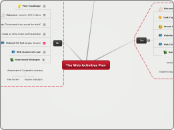arabera Luczia Bain 11 years ago
288
Planning Wb Activities
The plan centers on enhancing students' understanding of music through a series of online activities and assessments. The first activity involves an informal assessment where students'

arabera Luczia Bain 11 years ago
288

Honelako gehiago
- Summative assessment- Completion of a final product
- Assessed on concepts, knowledge, understanding and completion and quality of task.
-task to enhance cooperative learning- Interdependance, autonomy.
- Assessed through group accountability.
Teacher evaluation
Peer Review
The Music Lab: http://www.sfskids.org/templates/home.asp?pageid=1
The Viva Zone: http://www.musicaviva.com.au/vivazone/
Youtube
In groups of 2-3 people, create and online poster using Glogster and present to the class.
http://www.glogster.com/
There are 3 Parts to this task: (A, B, C)
Start with the following websites and any other sites of your choice:
The Music Lab: http://www.sfskids.org/templates/home.asp?pageid=1
The Vivazone: http://www.musicaviva.com.au/vivazone/
Part A: 1 Instrument from a culture
Part B: 1 instrument from the orchestra
Part C: Compare and Contrast both instruments.
PART A: Instrument from a Culture
Here is what to add on your poster:
1. Name the Instrument. Describe what it looks like and what it is made of.
2. Add images and Audio/ Visual clips of people performing using the instruments
3. Describe the Tone Colour of the instrument? Describe the sound and how it is played.
4. Histroy of the country and Music from the culture
5. Include the country flag.
PART B: Orchestral Instruments
Here is what to add:
1. Name the instrument. What does it look like and what is it made of?
2. Add images and Audio/ visual clips of people perfroming
3. Describe the Tone Colour of the instrument? Describe the sound and how it is played.
4. Name the instrument family that it belongs to.
5. Name some ensembles and bands that use this instrument.
PART C: Compare and Contrast
Write an explanation: Compare both instruments that you have studied:
1. What is similar and what is different?
Students are to research 2 different Instruments:
- An instrument from a culture of your choice.
- An instrument from the orchestra
The NSW board of studies Syllabus summarises that students are to be given Listening, Composing and Performing opportunities. The outcomes to be assessed/ covered with this task are to:
develop knowledge, understanding and skills in the musical concepts through listening as a means of extending aural awareness and communicating ideas about music in social, cultural and historical contexts. (p.12)
4.7 demonstrates an understanding of musical
concepts through listening, observing, responding, discriminating, analysing, discussing and recording musical ideas.
4.8 demonstrates an understanding of musical
concepts through aural identification and discussion of the features of a range of repertoire and instrumentation
4.11 demonstrates an appreciation, tolerance and
respect for the aesthetic value of music as an artform
NSW Board of Studies: http://www.boardofstudies.nsw.edu.au/syllabus_sc/pdf_doc/music_710_syllabus.pdf
Students will have previously discussed thier country of origin and discussed what world music they have thye listened to. Also, a listening activity based on aurally distinguishing between different styles, instruments and cultures is covered.
The word TONE COLOUR is also prior knowledge.
4.7
4.8
4.9
There are 2 tasks to complete in this activity/ lesson.
1. Students will complete an online quiz with a peer. This will be an Informal Summative quiz..
2. Students will create an online Glossary and will be peer and teacher evaulated.
Teacher Evaluation and peer evaluation
Actvity 1:
Theory Lessons: http://www.musictheory.net/lessons
Activity 2:
The Music Lab: http://www.sfskids.org/templates/home.asp?pageid=1
Activity 1: Students complete a Informal assessment testing thier knowledge and understanding of reading notation.
Activity 2: Students complete a 15 word/ symbol Glossary. They will provide the sign/ symbol or word and a definition. They will create an online poster.
The NSW board of studies Syllabus summarises that students are to be given Listening, Composing and Performing opportunities. The outcomes to be assessed/ covered with this task are to:
4.8 demonstrates an understanding of musical
concepts through aural identification and discussion of the features of music.
4.9 demonstrates an understanding of musical literacy through the use of notation, terminology and the interpretoing of scores.
NSW Board of Studies: http://www.boardofstudies.nsw.edu.au/syllabus_sc/pdf_doc/music_710_syllabus.pdf
Students come from a wide array of cultural backgrounds and we need to celebrate and acknowledge music from all backgrounds, styles and genres. This topic topic will broaden student perspectives on what music is by presenting world from around the world, Classical music and learning to read and play music. The unit of work is based on an 10 Week program and consists of 2 web based activities. These will be discussed here including the websites and webtools in greater detail.